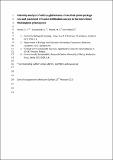Files in this item
Paternity analysis of wild-caught females shows the sperm package size and placement influence fertilization success in the bushcricket Pholidoptera griseoaptera
Item metadata
| dc.contributor.author | Parker, Darren James | |
| dc.contributor.author | Zaborowska, Julia | |
| dc.contributor.author | Ritchie, Michael Gordon | |
| dc.contributor.author | Vahed, Karim | |
| dc.date.accessioned | 2018-04-07T23:34:46Z | |
| dc.date.available | 2018-04-07T23:34:46Z | |
| dc.date.issued | 2017-06 | |
| dc.identifier | 249441911 | |
| dc.identifier | c8c2d54f-c275-46bc-8df8-73138ab67df3 | |
| dc.identifier | 85017434605 | |
| dc.identifier | 000402040000017 | |
| dc.identifier.citation | Parker , D J , Zaborowska , J , Ritchie , M G & Vahed , K 2017 , ' Paternity analysis of wild-caught females shows the sperm package size and placement influence fertilization success in the bushcricket Pholidoptera griseoaptera ' , Molecular Ecology , vol. 26 , no. 11 , pp. 3050-3061 . https://doi.org/10.1111/mec.14089 | en |
| dc.identifier.issn | 0962-1083 | |
| dc.identifier.other | ORCID: /0000-0001-7913-8675/work/46761135 | |
| dc.identifier.uri | https://hdl.handle.net/10023/13093 | |
| dc.description | This work was funded by the University of Derby (KV), NERC (DJP), and Erasmus and Erasmus Plus (JZ). | en |
| dc.description.abstract | In species where females store sperm, males may try to influence paternity by the strategic placement of sperm within the female's sperm storage organ. Sperm may be mixed or layered in storage organs, and this can influence sperm use beyond a ‘fair raffle’. In some insects, sperm from different matings is packaged into discrete packets (spermatodoses), which retain their integrity in the female's sperm storage organ (spermatheca), but little is known about how these may influence patterns of sperm use under natural mating conditions in wild populations. We examined the effect of the size and position of spermatodoses within the spermatheca and number of competing ejaculates on sperm use in female dark bushcrickets (Pholidoptera griseoaptera) that had mated under unmanipulated field conditions. Females were collected near the end of the mating season, and seven hypervariable microsatellite loci were used to assign paternity of eggs laid in the laboratory. Females contained a median of three spermatodoses (range 1–6), and only six of the 36 females contained more than one spermatodose of the same genotype. Both the size and relative placement of the spermatodoses within the spermatheca had a significant effect on paternity, with a bias against smaller spermatodoses and those further from the single entrance/exit of the spermatheca. A higher number of competing males reduced the chances of siring offspring for each male. Hence, both spermatodose size and relative placement in the spermatheca influence paternity success. | |
| dc.format.extent | 12 | |
| dc.format.extent | 5020992 | |
| dc.language.iso | eng | |
| dc.relation.ispartof | Molecular Ecology | en |
| dc.subject | Polyandry | en |
| dc.subject | Sperm competition | en |
| dc.subject | Spermatodose | en |
| dc.subject | Post-copulatory sexual selection | en |
| dc.subject | Cryptic female choice | en |
| dc.subject | QH301 Biology | en |
| dc.subject | DAS | en |
| dc.subject.lcc | QH301 | en |
| dc.title | Paternity analysis of wild-caught females shows the sperm package size and placement influence fertilization success in the bushcricket Pholidoptera griseoaptera | en |
| dc.type | Journal article | en |
| dc.contributor.institution | University of St Andrews. Centre for Biological Diversity | en |
| dc.contributor.institution | University of St Andrews. School of Biology | en |
| dc.contributor.institution | University of St Andrews. Institute of Behavioural and Neural Sciences | en |
| dc.identifier.doi | 10.1111/mec.14089 | |
| dc.description.status | Peer reviewed | en |
| dc.date.embargoedUntil | 2018-04-07 | |
| dc.identifier.url | http://onlinelibrary.wiley.com/doi/10.1111/mec.14089/full#footer-support-info | en |
This item appears in the following Collection(s)
Items in the St Andrews Research Repository are protected by copyright, with all rights reserved, unless otherwise indicated.

